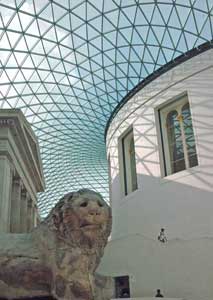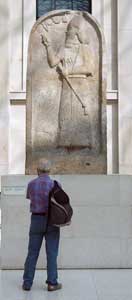| Collections
|
|||||
|---|---|---|---|---|---|
| Korea | |||||
|
|
|||||
 |
Like the relief of Assyrian King Ashurnasirpal II in the Great Court under Sir Norman Foster's dome, The British Museum is an imposing presence. It should be at the top of any visitor's list of what to see in London, although these days, for some, the London Eye has pride of place. The list of treasures the Museum houses glitters with famous names: The Elgin Marbles from the Parthenon, The Rosetta Stone, sculptures from the Mausoleum of Halikarnassos, treasures from the Sutton Hoo ship burial.... While the Museum has had a significant presence on the Internet for some time now, its website (available only in English) is very much a work in progress. Until recently it was possible to search collections easily through a direct link to "Compass" as the access point to collections on line. Now that has disappeared, leaving many dead links around the world which had connected to the museum's material via "Compass" and leaving a bit of a puzzle as to how best to access what is still over 4000 objects in the Museum which have been placed on line with descriptions. With "Compass" gone, select "Explore" from the options under the title on the opening page. In the middle of the "Explore" page is a little search box, where one can enter key word(s). That in turn will bring up an array (often very large) of thumbnailed images and captions, with the option then of refining the search by key word, geographically or chronologically. As with any search mechanism, effective use of this takes a little practice. For example, "Islamic ceramics" as a search term brought up some 377 items, many of which were not necessarily Islamic or ceramic nor had any obvious relationship to the two. Refining the search using the term "lustreware" as oppposed to using "lustre" narrows the selection to a few items but brings up different results in each case. |  |
The "Explore" page provides options for further searching by themes (so far few), galleries (that is, the display rooms in the museum), world cultures, etc. Searching under such categories will highligh objects, for each of which there will be a selection of supposedly related objects. However, there is no easy way to browse in the way that one can, for example, for the collections in the Louvre. (BM should learn from what the Louvre has done in this regard.) The challenges of obtaining an overview can be seen if one goes, say, via "Galleries" to Room 33, which encompasses a huge body of material from China, India, South Asia and Southeast Asia. The website is designed for discovery by serendipity, but not to facilitate systematic searching. For a number of the most famous collections (notably various "hoards" of gold and silver objects), websites other than that of the Museum provide a far more thorough photographic record than so far can be found at the Museum's own site. Moreover, unlike at the Louvre, one cannot do a walk through the objects as they are displayed in order in their galleries, where in fact the curators have grouped materials in very helpful ways. Of course the user of the website should remember, there is no substitute for visiting the museum itself.
Among the relatively few focussed groupings of British Museum material which should be of direct to Silk Road enthusiasts note:
- The Oxus treasure, found in what is today Tajikistan--a collection of spectacular gold and silver objects from the Achaemenid period in Persia;
- "Iran before Islam: the Sasanians";
- Painted Buddhist banners from the Mogao Caves at Dunhuang (part of the huge collection of material brought back by Aurel Stein);
To date, a good portion of the material one might wish to see on the website is not there--for example, much of the Aurel Stein collection apart from the selection of banners. The explanation for this in part is the fact that the International Dunhuang Project, based at the British Library, has taken on the task of digitizing all the East Asian Silk Road material in the British Museum, British Library and Victoria and Albert Museum. Thus, one may already search via the IDP site almost all of the Dunhuang banner collection in the BM in superb images or view some 2000 of Aurel Stein's photographs from his expeditions, but the IDP collection of other objects such as stucco sculptures is as yet limited. IDP is also including significant materials from other collections of Silk Road art (e.g., at the Musée Guimet in Paris and the Museum für Indische Kunst in Berlin). All this will make websites such as the one here obsolete.
The image galleries presented here on Silk Road Seattle extend considerably the number and range of objects available in digital form from the British Museum collections. Most of the images are of high quality, some slightly less than sharp but still serviceable. The selection is far from comprehensive, governed by the limited time I could spend at the task. Thus there is significant material for Chinese Central Asia and for the Islamic world, a decent array of coins from various periods and places, some valuable Kushan-Bactrian material. However, I have done nothing with the rich South Asia collections, have only a couple of samples from Korea, nothing from Japan..... Since the pre-Islamic Middle East gallery was closed, that material will have to wait for another time, although fortunately the museum itself has posted a good many of the most significant objects. One feature of the selection here is the links which have been provided both to specific pages on the Museum's own site with discussions of individual objects and to analogous material in other museums' collections. Obviously more needs to be done with this kind of cross-referencing. References to print images also remain to be added. In fact there is a substantial body of published discussion of the BM Silk Road material, thanks to a number of exhibitions in recent years and to the cataloguing of some parts of it (e.g., the Dunhuang banners).
All the color photographs were taken in May 2007 and are copyright © Daniel C. Waugh. They may be used for non-profit educational purposes, but please ask permission first, since that helps me track the value of this material. I am generally not in the business of selling rights to higher resolution images even where I have them; for such queries, please contact the Museum's permission department and obtain photographs directly from them. The British Museum was a generous contributor of images to Silk Road Seattle's virtual "Art of the Silk Road" Exhibition.
Last modified June 2007.